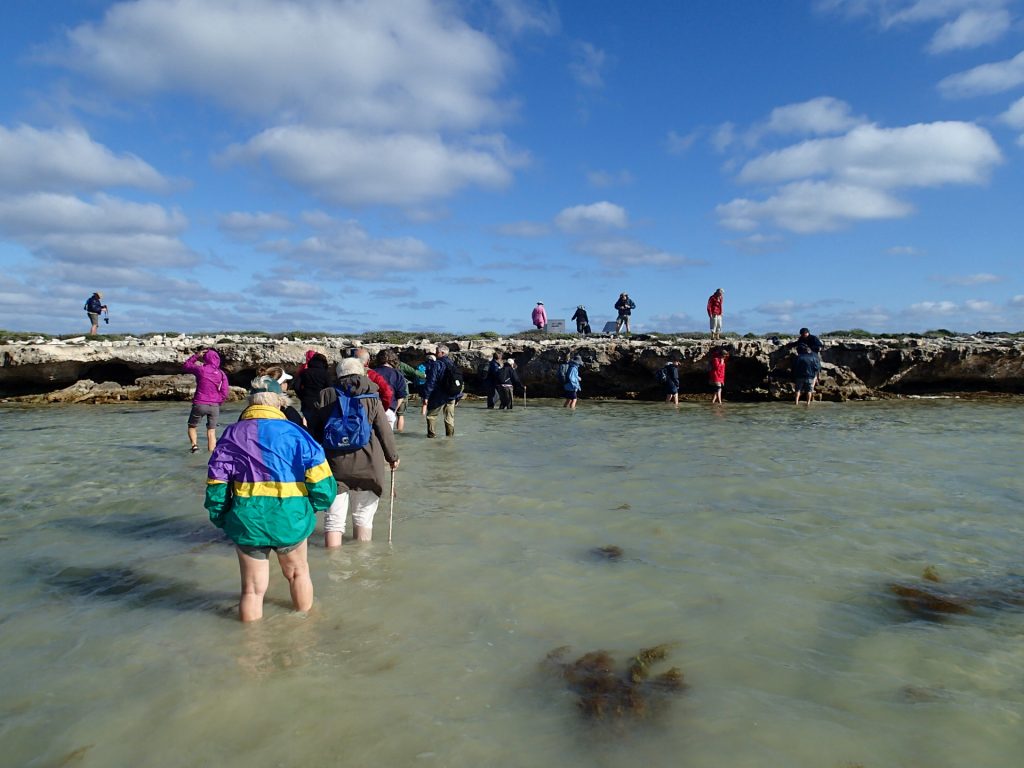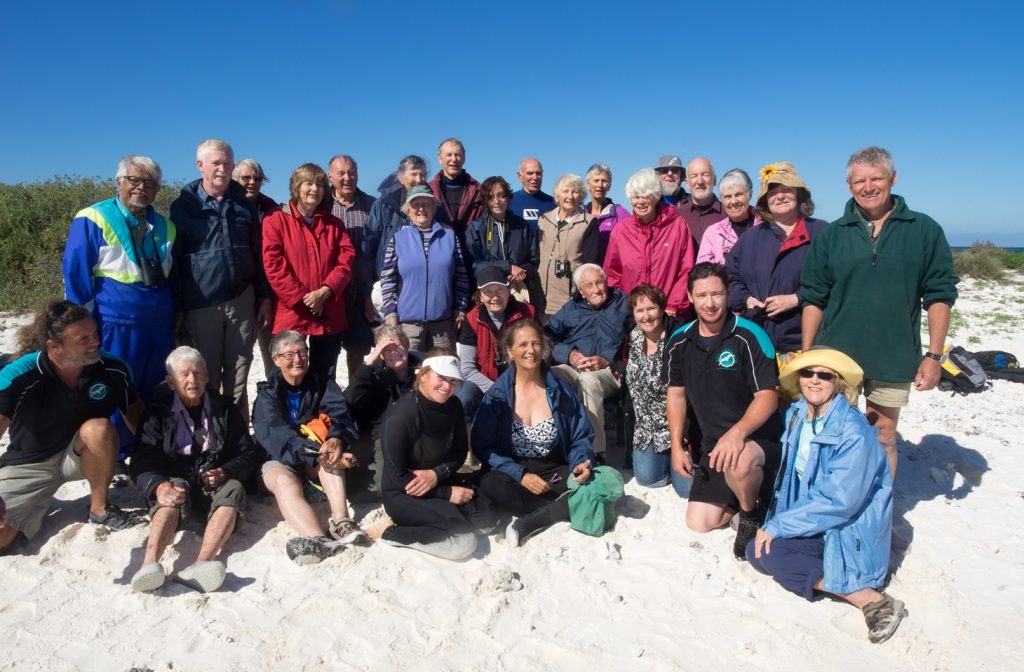
30 April- 5 May 2016
It had been many years since the Naturalist Club had organised a trip to the Houtman Abrolhos Islands so it was not surprising that our quota of 25 was filled rapidly. Only two members had previously visited the islands – David Goodall AM who conducted research on the gap size in craypots for the Department of Fisheries and the CSIRO in 1963 and Elva Letts who was on the first Abrolhos trip conducted by Kevin Coates.
Day 1: Saturday, 30 April
After picking up participants at Nedlands and North Beach our two vehicles travelled along Indian Ocean Drive to Hangover Bay where we enjoyed, morning tea, a close up view of the ocean and a toilet stop- not necessarily in that order! Next stop was lunch at Port Denison. We arrived in Geraldton around 2.45pm and made straight for the Museum to view the displays relating to the Houtman Abrolhos Islands and the Story of the Batavia. Our landward journey ended with a visit to the HMAS Sydney Memorial which overlooks the town and ocean in which the entire crew of 645 perished.
We were welcomed aboard the EcoAbrolhos, our home for the next 4 days, by Sonia and Jay Cox, part owners of the vessel, and the rest of the crew. The 35m vessel turned out to be very different to the cray boats David and Elva had endured. Two qualified chefs, a well-stocked bar, air-conditioned rooms with ensuite spread over three decks and a very comfortable lounge, ensured we were well catered for. The choice of three pizzas for dinner and the first of many red wines and G&Ts concluded our first day.
Don Poynton
Day 2: Sunday, 1 May
The EcoAbrolhos left Geraldton at 6 am for the Pelsaert Group of islands, the southernmost of the three groups that make up the archipelago. We were warned that our crossing to the islands would be rough however with a couple of exceptions we were up for breakfast and looking forward to our first landing, at Post Office Island to visit the pearl farm. We learnt about the three kinds of pearls grown at the farm* and the delicate process of seeding the pearl shells which is done by Japanese experts. The island also provided the first opportunity to examine the vegetation, which included Blueberry Bush (Myoporum insulare), Coast Saltbush (Atriplex cinerea), Nitre Bush (Nitraria billardierei), Seaberry Saltbush (Rhagodia baccata) and at least three types of samphires. Our on board naturalist, Dr Chris Surman, pointed out abandoned Roseate Tern nests and the distressed Grey Mangroves (Avicennia marina) which he attributed to insufficient rain in recent years to dilute the overload of nutrients derived from the build-up of guano from roosting birds.
* black pearls from Black Lipped Oyster (Pinctada margiaritifera), white pearls, known as Akoya pearls, from Pinctada fucata, and the irregular non-spherical pearls known as Baroque pearls.
Our afternoon excursion was to Basile Island where we enjoyed a coffee with the Scarpuzza family – Peter and his son Nino, made the Italian way, in a big old percolator. We also visited the island’s little Catholic church.
Don Poynton
Day 3: Monday, 2 May
After breakfast, we cruised to the Easter Group of islands then travelled in the glass-bottomed boat to The Squid Hole on Wooded Island where many of us snorkelled around the coral. Fish were plentiful, ranging from Baldchin Groper and schools of Buff Bream, through Moon Wrasse and brightly coloured fish of all shapes and sizes, to Clownfish (below) and tiny strips of electric blue.
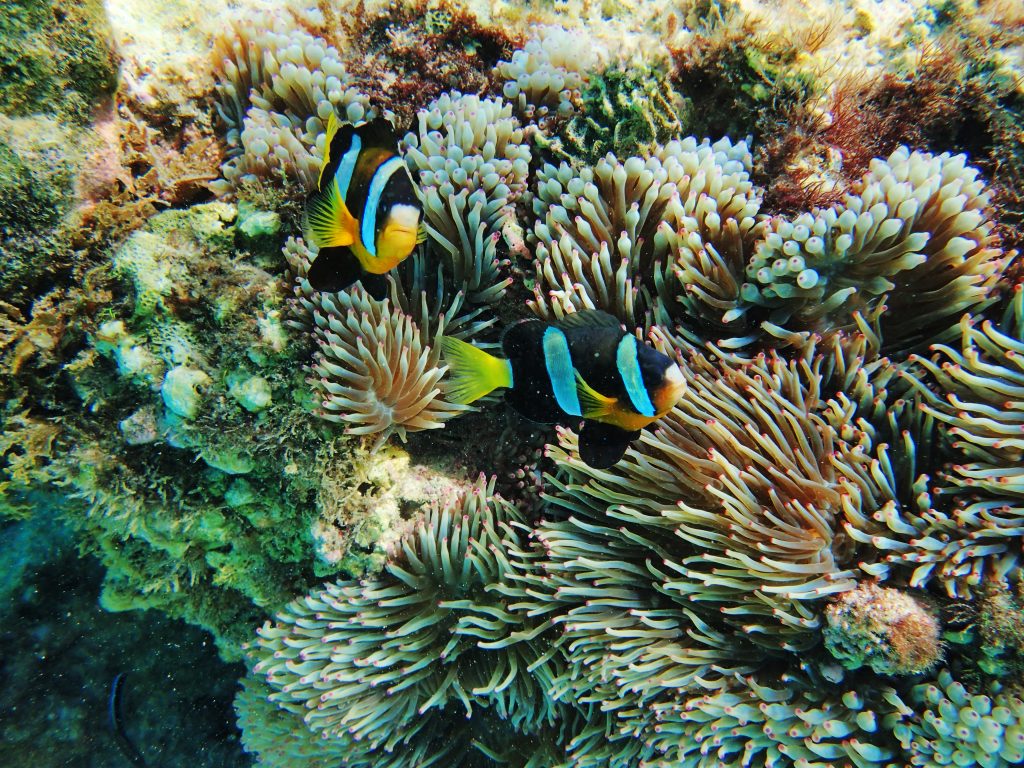
On the island, birds included Pied Cormorants, Silver and Pacific Gulls and a single Lesser Noddy. Chris pointed out a nest site of a Pacific Gull and some people saw a Pacific Gull dropping a shell to break it open – the beach was strewn with broken shells. In the mangroves were many old nests of Lesser Noddys – we could tell which had been successful by the amount of guano. Chris also pointed out a nest of ‘gold-bum’ ants (Polyrachis ammonoeides).
We had hoped to land on Little Sandy Island to swim with the Sea Lions that live there, but it was too windy. Just before sunset, however, near where we anchored for the night, we were thrilled to see a huge flock of Roseate Terns circling and diving into the ocean to feed. They were accompanied by a number of Wedge-tailed Shearwaters, the most numerous species in the archipelago.
Our dinner of fresh crayfish and a film about the wreck of the Batavia, whose site we had passed during the afternoon, completed a day that was full of excitement and interest.
Jacquie Gregson
Day 4: Tuesday, 3 May
West and East Wallabi Islands in the Wallabi Group are geological remnants of the mainland in stark contrast to the other smaller coral rubble islands.
On approach across the shallows of West Wallabi Island, we were welcomed by an aerial dance by 5 White-bellied Sea Eagles, and noted the return of a pair of Shelduck. This island was the refuge for soldiers from the Batavia banished by the mutineers on Beacon Island. As we waded ashore to clamber up a 2m broken limestone cliff we felt for (and like) the survivors of the Batavia.
We wandered among limestone slabs observing windswept ground hugging plants including red flowering Wild Rose (Diplolaena grandiflora), Sea Heath (Frankenia pauciflora) with tiny flowers and tangles of Sarcostemma viminale with its white sap. As we walked out to Webbie Hayes’ fort in a dip in the centre of that part of the island, we passed an Ospreys nest piled up by the path, a mix of sticks, sea weed and flotsam. Some saw timid Tammar Wallaby hiding in the scrub. There is considerable morphological differences between the West and East Wallabi islands’ populations. The limestone slabs of the fort were a perfect sunning spot for a King’s Skink (Egernia kingii) (very spotted). Nearby was a soak, the edges polished in places where generations of wallaby and other animals had endeavoured to find a drink.
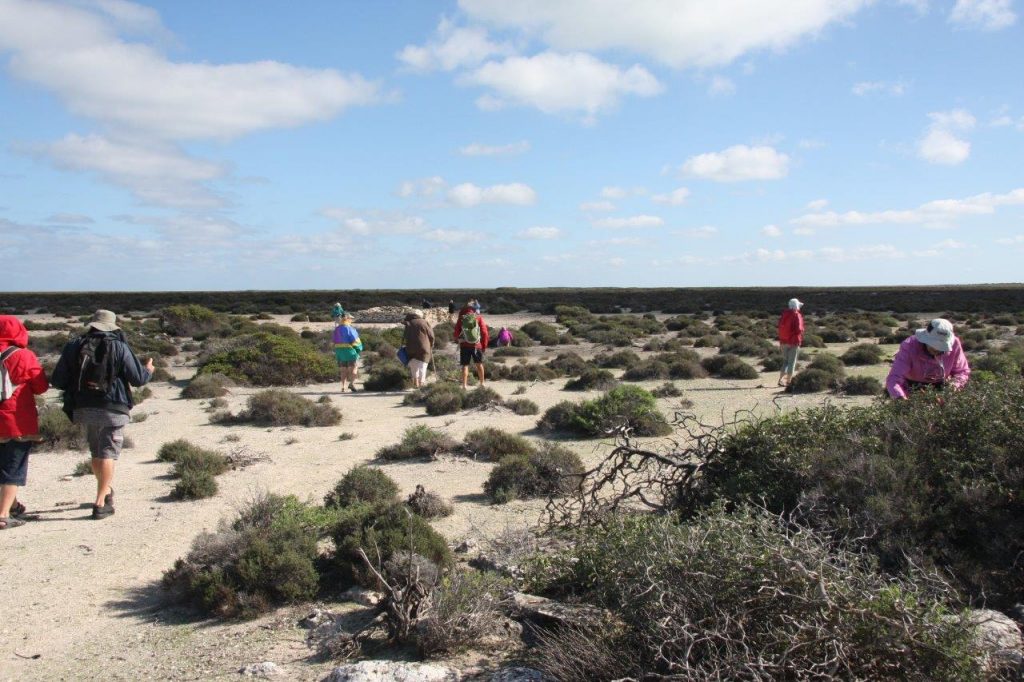
Under loose slabs, Chris revealed the home of a family of Spiny Tailed Skink (Egernia stokesii stokesii). This may be a distinct species following recent DNA work. Similar habitat hid a Bynoe’s Gecko (Heteronotia binoei) and the sloughed skin of a carpet python (Morelia spilota varigata). Elsewhere Gane, our Coates’ driver, uncovered a Barking Gecko (Underwoodisaurus milii) and some very colourful black and gold banded bush cockroaches, possibly Imposter sleepy cockroach (Anemesia polyzona). There were a couple of LBB’s around, Silvereye and White Faced Robin and the remains of a bleached turtle shell.
As the tide was ebbing we made a hasty retreat to the boats before being stranded. Once on board the EcoAbrolhos we enjoyed another tasty meal partly foraged from the sea and travelled around to Turtle Bay, off East Wallabi Island, where some snorkelled and saw numerous fish, including clown fish and a bright orange nudibranch. Non-swimmers either kayaked or walked up to the top of the headland, near the airstrip, where they observed a Dwarf Bearded Dragon (Pogona minor minima), more sea eagles and osprey, oystercatcher, Pacific Gulls and a Red-capped Plover trotting along the shoreline.
As the wind and swell rose we travelled southward again, past the reef with foaming waves where the Batavia was wrecked and Beacon Island where some of the lucky survivors escaped to. A wild and bleak place as we hastened to moor in the shelter of the Easter Group of islands.
Jane Tucker
Day 5: Wednesday, 4 May.
As per usual I was up by 6am in the morning, savouring a cup of coffee and waiting for the sun to arise. Today is our last day in the Abrolhos and we were planning on visiting the sea lions at Little Sandy Island after breakfast. Suddenly the fire alarm went off and everybody went to the muster station on the main deck. Two persons were missing at the roll call and when checking the alarm was a false alarm. That of course was to the embarrassment of one of our party and to the hilarity of everybody else, except maybe the crew.
During and after breakfast Noramly suddenly started catching more than one fish, probably a school of Pink Snappers that had swam under the boat. Soon other people were helping catch fish for our lunch, as Noramly had promised fish curry. We finished fishing at 8.30am with enough caught for lunch. However not before a pod of dolphins cruised past.
At 9am we pulled anchor and went to see the sea lions, (a few lucky people were able to swim with one of them) as well as to have our group photo taken. With attentive help from the crew our oldest member, David Goodall, also managed to get ashore for the photo. We had a look around, it really is a small sandy island, and were soon ferried back to the vessel where our fish curry lunch awaited.
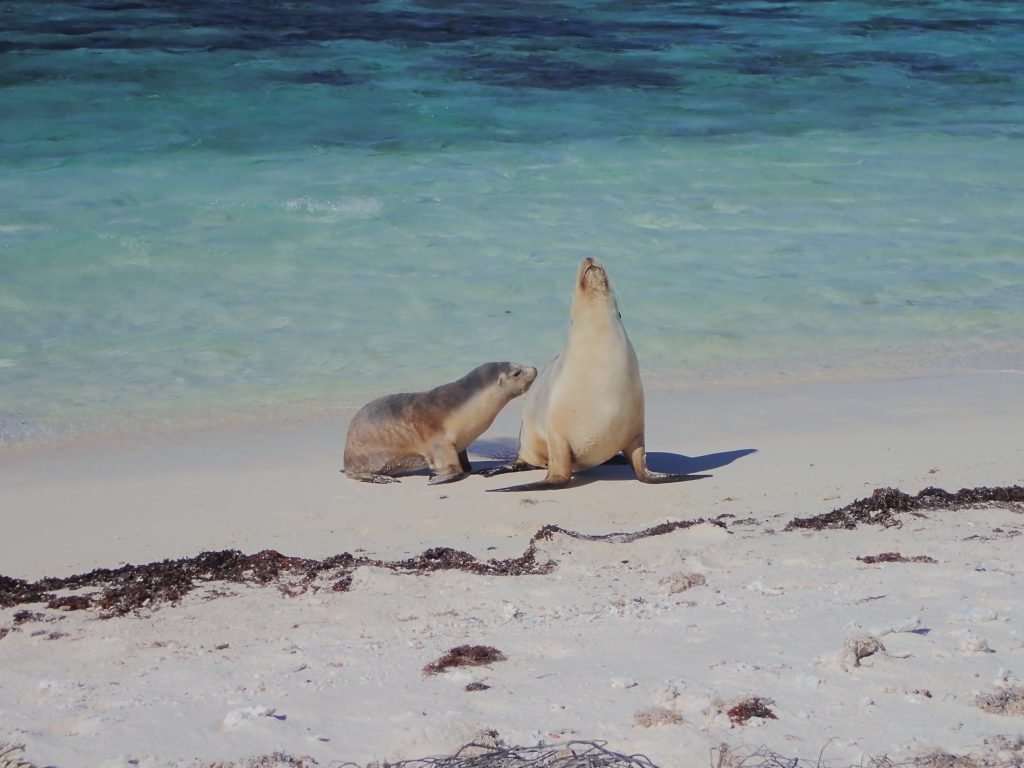
After lunch we travelled back to Geraldton. There were large swells predicted and the vessel did sway as soon as we started leaving the Easter Group of islands. It got so bad that two people got thrown out of their seats and landed on the floor. Luckily nothing broken but it wasn’t a good start of our trip back. Soon after, the first calls for an empty bucket went up. We had one more casualty during the 5 ½ hr trip back to Geraldton which was also not serious. Back in port we moored next to the Chinese vessel that was impounded by the police. Channel 7 news was just about to start so we watched the item about the mystery vessel and then went out for a meal at Skeetas restaurant overlooking a marina. All in all it was a good ending to a rather unusual day.
Jolanda Keeble
Day 6: Thursday, 5 May
As a special favour to the Nats Club, we were able to stay on board the EcoAbrolhos overnight. A farewell to the crew and an early breakfast at Skeetas was the start of our last day. Gane had the trailer’s electrical connection fixed in no time and we set off down the coast. Morning tea was had in the beautiful Dynamite Bay at Green Head.
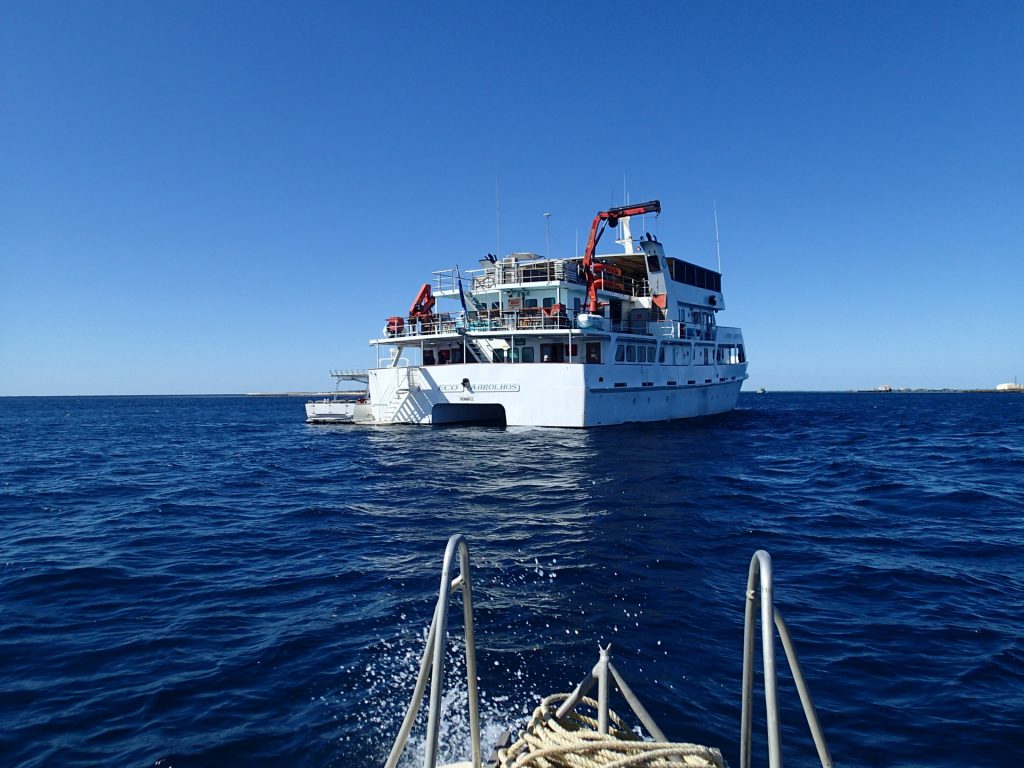
A stop at the Pinnacles gave us time for lunch and a short walk in this strange landscape. Their formation remains controversial – they are either solution pipes, preserved tree casts, or the result of minerals accumulating around tree roots. In any case, the surrounding calcareous sand has blown away to expose the calcrete pillars. An emu and his young were seen as we drove in, a Wedge-tailed Eagle flew over, and Glenda spotted a Mistletoe Bird for us – a tiny bird with a brilliant red breast. The Tail Flower (Anthocercis littorea) was flowering in profusion. Other plants in bloom were the Basket Bush (Spyridium globulosum), the Prickle Lily (Acanthocarpus preissii) with its sweet scent, an erect form of the Snake Bush (Hemiandra sp.), the Coastal Beard Heath (Leucopogon parviflorus) and the Buttercup (Hibbertia subvaginata).
On the way home, Don Poynton drew our attention to several energy sources or potential ones. We passed several wind farms and the Dongara Gas Field. There are the coal seams south of Mt Lesueur and elsewhere, which luckily have not been exploited. We saw an oil platform offshore from Cliff Head. North-east of Leeman there is an area of deep hot rocks – a potential source of geothermal power. And at Arrowsmith there is also the potential for shale gas produced by “fraccing”.
We returned to Perth tired but satisfied having seen over 30 species of birds, 6 reptile species and 3 mammal species plus numerous plant species. It had been an enjoyable trip.
Mike Gregson
Click on link for Houtman Abrolhos Islands Species List
(This is not a complete list as some flora or fauna could not be positively identified even at genus level)
Participants: Haydee Adel, Peter & Barbara Alcock, Barbara Baxendale, Audrey Bolger, Pam Ghirardi, David Goodall, Karen Goodall-Smith, Mike & Jacqueline Gregson, Amanda Griffiths, John & Ruth Karajas, Jolanda Keeble, Barbara Kent, Margaret Larke, Elva Letts, Diana Libby, Bin Muslim & Glenda Noramly, Don Phillips, Don Poynton, Fabienne Rozsa, David & Jane Tucker, Gane Doyle (Coates).
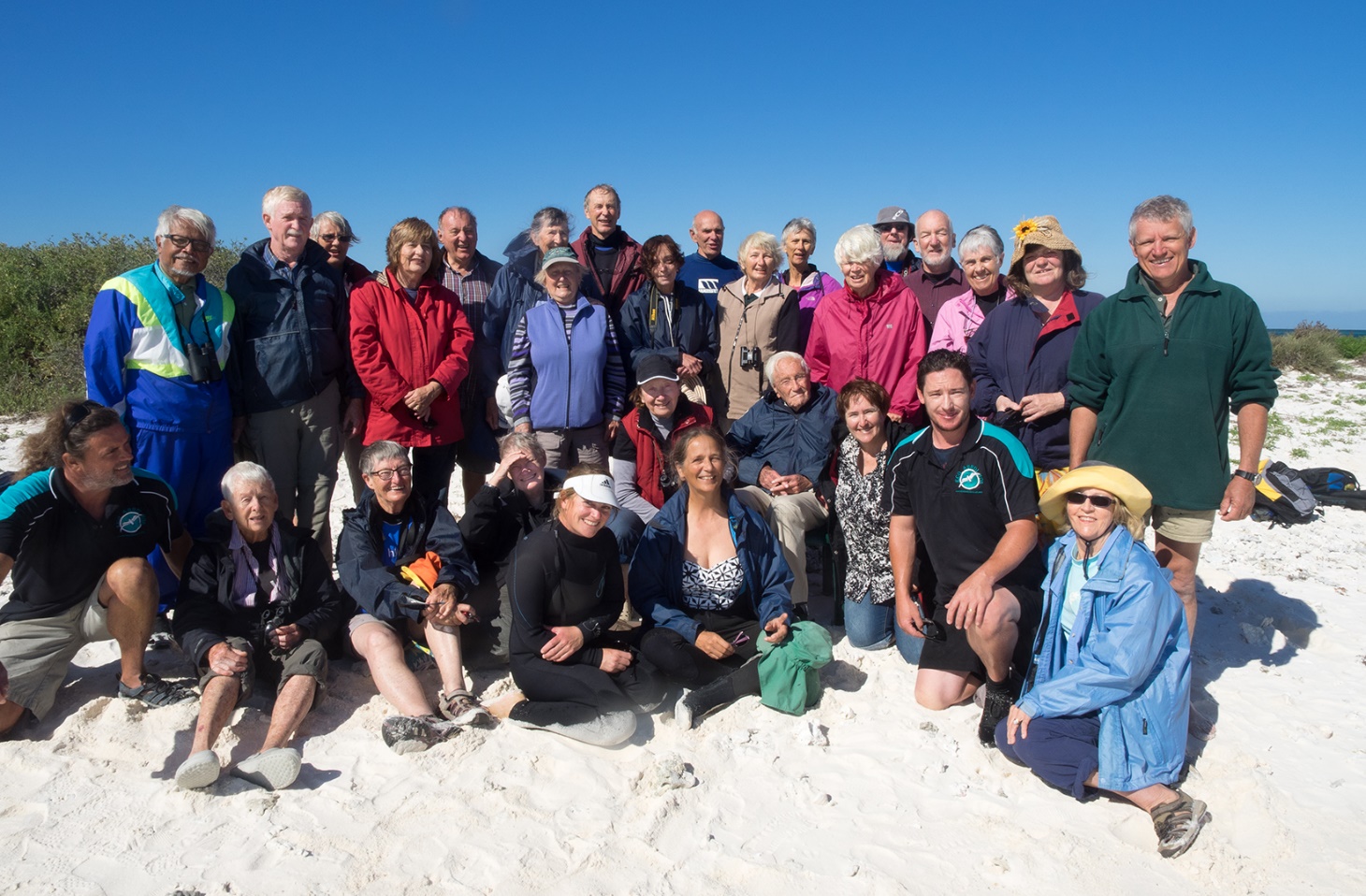
Backrow: Jane Tucker, John Karajas, Elva Letts, Don Poynton, Peter Alcock, Barbara Alcock, Don Phillips, Mike Gregson. Second Row Standing: Bin Muslim Noramly, David Tucker, Ruth Karajas, Barbara Baxendale, Fabienne Rozsa, Barbara Kent, Jacquie Gregson, Haydee Adel, Amanda Griffiths, Gane Doyle (Coates). Middle Row Kneeling: Glenda Noramly, Dianne Libby, David Goodall AM, Karen Goodall-Smith. Front Row Kneeling: Dr Chris Surman ( EcoAbrolhos), Audrey Bolger, Margaret Larke, Rachel (EcoAbrolhos), Jolanda Keeble, Darren ( EcoAbrolhos), Pam Ghirardi.


